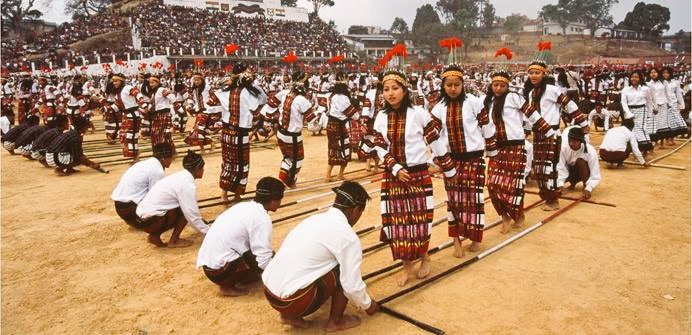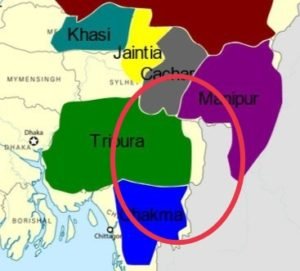The Origins of Kuki Problems in India


The 1760s saw a new entrant in the Chittagong Theatre – the British. The British, after placing Mir Jafar on the throne slowly started taking over parts of Bengal for their revenue and not unexpectedly, it led to rebellions almost from day one – starting with Dhalbhum. 1761, the British took over Chittagong and immediately started on reassessment of tribute. In time, the focus shifted to Tripura and the Chakmas, the two main Mughal tributaries of the area.

In 1772, the British demanded an enhanced tribute from the Chakmas who used to pay five maunds of cotton as tribute. Chakmas were never really under the control of Mughals and generally submitted only in the face of overwhelming military power. The Chakmas as usual, refused and by 1776, it erupted into open war with the British. A British army sent in 1777 into the Chakma Hills was destroyed. From 1783 to 1785 AD the Company’s lease-holders could not enter the hill tracts and as a result, the revenues of this area fell into arrears. By 1787, with no option left, the British put the whole hill territory under an economic blockade forcing the Chakma Raja Jan Baksh Khan to surrender. The Chakmas had to pay a tribute of 501 maunds as against the usual five!! This campaign brought them in direct contact with the Kukis who sided the Chakmas. The British tried to turn the Kukis against the Chakmas but the Kukis stood steadfastly behind their king.
In 1761, the British sent an army against Tripura to realize their tribute. However, when they entered Tripura, they realized that the territory was already under the control of Mughals and there was no need to conquer thr area. In fact, Tripura is in a curious position. In 1732, Jagat Manikya, one of the Princes of Tripura invaded his country with Mughal support to seize the throne. Dharma Manikya, the king of Tripura fled into the hills and the Mughals installed Jagat Manikya into the plains area of Tripura. In time, this rebel kings in the hills and loyal king in the plains arrangement failed and Dharma Manikya petitioned the Mughals to get control of the kingdom – he got it but it resulted in a unique situation – the plains area, called Chakla Roshanabad is now a Zamindari. In synopsis, the king of Tripura is a Zamindar in the plains and a king in the hills!! The British entered Tripura plains with an army without knowing this arrangement. They returned and soon, a new tribute of one lakh and an army maintenance cost of 45,463 was imposed on Tripura plains which is as good as separate from Tripura. After some time, Jagat Manikya’s son Balram was given the Zamindari rights to Chakla Roshanabad and in time, disputes cropped up over time. The British entered Hill Tripura, the kingdom part. The Kuki who were supporting the king were angry at the British interference.
Cachar was too far from any British outpost in the area. However, when the Burma-Manipur War escalated, it sucked every entity into the war with Cachar and later, Ahoms being the most prominent. Manipur asked Cachar for help and even though Cachar-Manipur alliance beat back the Burmese, the subsequent invasions led to the Burmese conquest of all the areas. This soon escalated into a fight with the British and after the Burmese were ejected out, Govindachandra, the Kachari king was restored back on throne. On his successionless death in 1830, the kingdom was annexed by the British under Doctrine of Lapse in 1833.
One of the first references to Kukis in Manipur is from 1723. In fact, their presence in the area is not a surprise because they existed in the area between Burma, Manipur, Chakma, Tripura and Cachar and the forests in the area and the ease of assimilation pushed into the gap – waves after waves came to habitate the area or pushing the existing residents towards India. However, when the disturbances were out of control, Tripura, Manipur and the others of the area forced them into submission and didn’t bother about their way of life.
From 1830s, the British started production of tea on commercial scale. Vast areas of Chittagong, Sylhet and Cachar were converted to tea plantations. However, this expanding commercial venture soon started encroaching into Tripura – both from the direction of Sylhet and from the direction of Cachar. This plus a British military unit sent into Tripura a few years ago against the British promise of non intervention in Hill Tripura soon brought the Kukis and British into open clash. After all, all the territories Tripura lost to Cachar were inhabited by Reang and Kuki.
On the other hand, a new martial clan of Kukis was taking shape in Myanmar – the Lushei. The Lushei Tribe, an offshoot of the Paihte entered Lushai Hills in 1830s and Chakma intervention is known even from that time. Repeated turf wars amongst them led to them scattering into Tripura and Chakma Hills. This was a powerful military confederacy in itself and forced the existing tribes in the area to flee in all directions. This came to be known as the First Kuki Wave and these tribes which fled were called Old Kukis. The next wave was when the Lushei attacked the powerful Thados and decimated them.
Manipur, Guite Chin, Chakmas and Tripura – all intervened in this and controlled the spillover but the problem came from the other direction – the Kuki plunder into Cachar and Chittagong tea plantations. One report notes that four Lushai were “shot like birds” for tapping rubber from British territory in 1883.
That, combined with the British encroachment into Kuki territory(till then, they were reporting to non-interfering suzerains) soon led to open clashes between the British and Kuki – and unlike in the previous cases, we would see attacks in all directions – Kuki flight into Manipur, Tripura and Cachar, Kuki raids from Tripura into Sylhet, towards Rangmati to the extent that the whole tract from Roshanabad(Comila) to Chittagong coupled with the Lushai raids chasing the fleeing Kukis. When the Lushei Sailo Civil War started, things started to turn even uglier.
By 1860s, the British, who now controlled Burma as well decided to act. In 1870, the British took over the Lushai Hills, which was ruled by Tripura calling it as a disturbed area. The first invasion of Lushai Hills in 1871 ended as a disaster and the second one in 1888 too met the same fate. However, a followup expedition the next year took Aizwal and subdued the Lushai. In fact, the invasion was a god send for the Lushai because they were about to be extinguished by the next tribe in the wave – the Fanai.
By 1895, the area was pacified and Chakma ruled territory was merged into it in 1898 forming the Lushai Hills district. However, it is important to note that North Lushai Hills which the British pacified was Tripura’s territory and Tripura repeatedly petitioned to have the territory back. The British didn’t bother to transfer it back and permanently kept it with itself!! This illegal transfer of land seems to have reduced Tripura’s land by half!
Two years after the Lushai Expedition, in 1892, the first missionaries entered Lushai Hills and conversions started in two years. At this point, it is interesting to understand why the British, which after pacification of Lushai Hills, rather than handing it back to Tripura, clubbed it with additional Kuki territory and declared it British property. The Political Officer of the 1889 Expedition, John Ware Edgar is known to have said that the transfer was opposed by the Missionaries who had a fertile harvesting ground in the area. One would see the impact of this as till 1947, the conversion in Tripura and Manipur was near to nothing while half of Lushai Hills converted to Christianity by 1931. The same level of conversions happened in Chin areas of Burma as well.
This has created two problems –
This led to demands of merger of Mizo territory into Burma and not India in 1947 which was overruled. By 1952, from this core of Chin territory in India arose demands for a united Chin state in India and by 1959, it was extended towards an independent country. Peace was restored only in 1980s.
On the other hand, post independence, Manipur saw massive Christianization of its tribal population – both Kuki and Naga. While the Christian population of Manipur stood at 12% in 1951, it is near to 41% in 2011 and above 90% in both Kuki and Naga. In spite of that, there were turf wars as like the 1997 Thadou-Paihte clash with the Mizo and Chin groups openly siding the Paihte and the Myanmarese Chin freely moving between India and Myanmar only complicated the matters further.
This, coupled with the Meiteis being overwhelmingly Hindu gave this a new dimension. In fact, there are four major dimensions of it.
In essence, what we see here is two races having different geographical concentration and with different religion and political representation fighting for domination in Manipur.
And one would notice that the root cause of all these problems is the British refusal to hand over Lushai Hills to Tripura due to missionary pressure and formation of a single Christian Kuki district which was different from its neighbours in India from every angle.
DISCLAIMER: The author is solely responsible for the views expressed in this article. The author carries the responsibility for citing and/or licensing of images utilized within the text.
